Most viewed
- Page Path
-
- HOME
- BROWSE ARTICLES
- Most viewed
"Most viewed" Articles are from the articles published in 2022 during the last six month.
- Original Article
- Hematology
- Changes and correlations of T-cell coinhibitory molecule programmed death-1 and interferon-γ in pediatric immune thrombocytopenia (648 times)
- Fady Mohamed El-Gendy, Amira M.F. Shehata, Esam Awad Abd El-Kawy, Mahmoud Ahmed El-Hawy
- Clin Exp Pediatr. 2023;66(3):127-133. Published online February 24, 2023
-
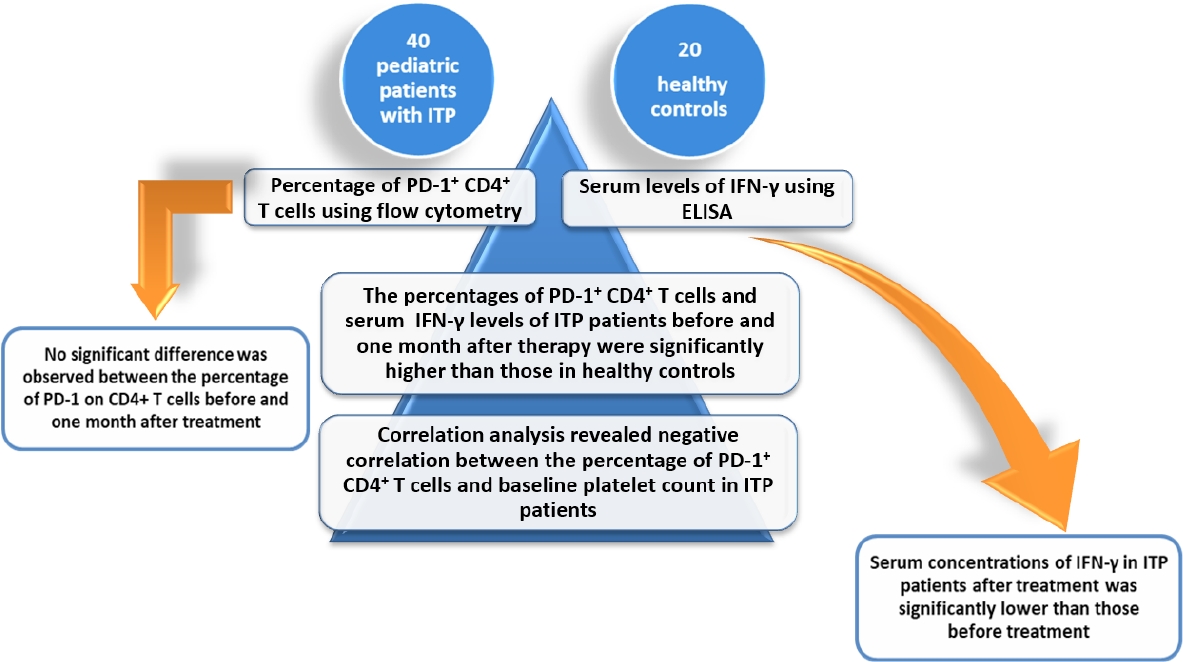
Question: What are the PD-1+ CD4+ T cells percentages and serum interferon gamma (IFN-γ) levels of pediatric patients with immune thrombocytopenia (ITP)?
Finding: Compared with healthy controls, the PD-1+ CD4+ T cells percentages and IFN-γ levels were significantly higher in ITP patients before and 1 month after therapy.
Meaning: Our findings suggest that PD-1+ CD4+ T cells and IFN-γ are involved in the pathophysiological process of ITP.
- Letter to the Editor
- Allergy
- Increased serum eosinophilic cationic protein in children with nonspecific chronic cough (639 times)
- Young Hwan Kim, Yoon Young Jang, Jieun Jeong, Hai Lee Chung
- Clin Exp Pediatr. 2023;66(10):455-457. Published online September 14, 2023
-
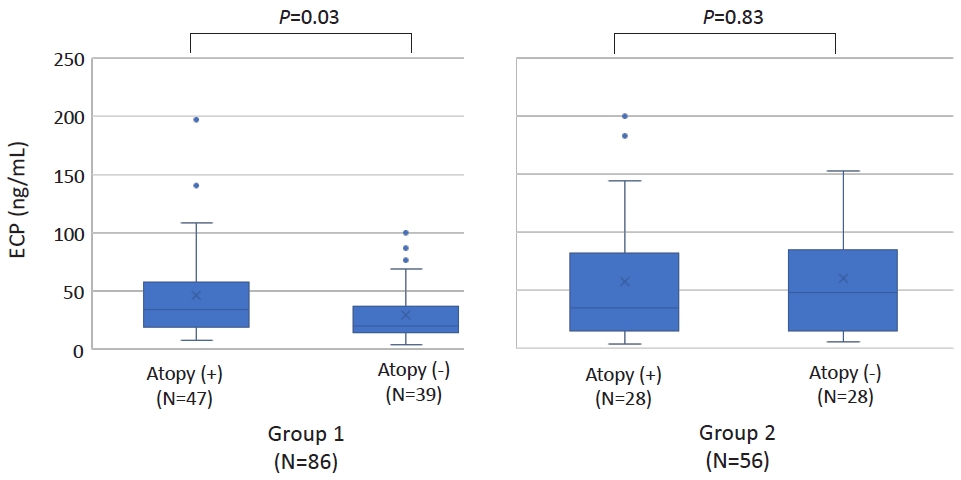
- Original Article
- Infection
- Predicting COVID-19 transmission in a student population in Seoul, South Korea, 2020–2021 (637 times)
- Young Hwa Lee, Han Ho Kim, Young June Choe
- Clin Exp Pediatr. 2023;66(4):173-178. Published online December 22, 2022
-
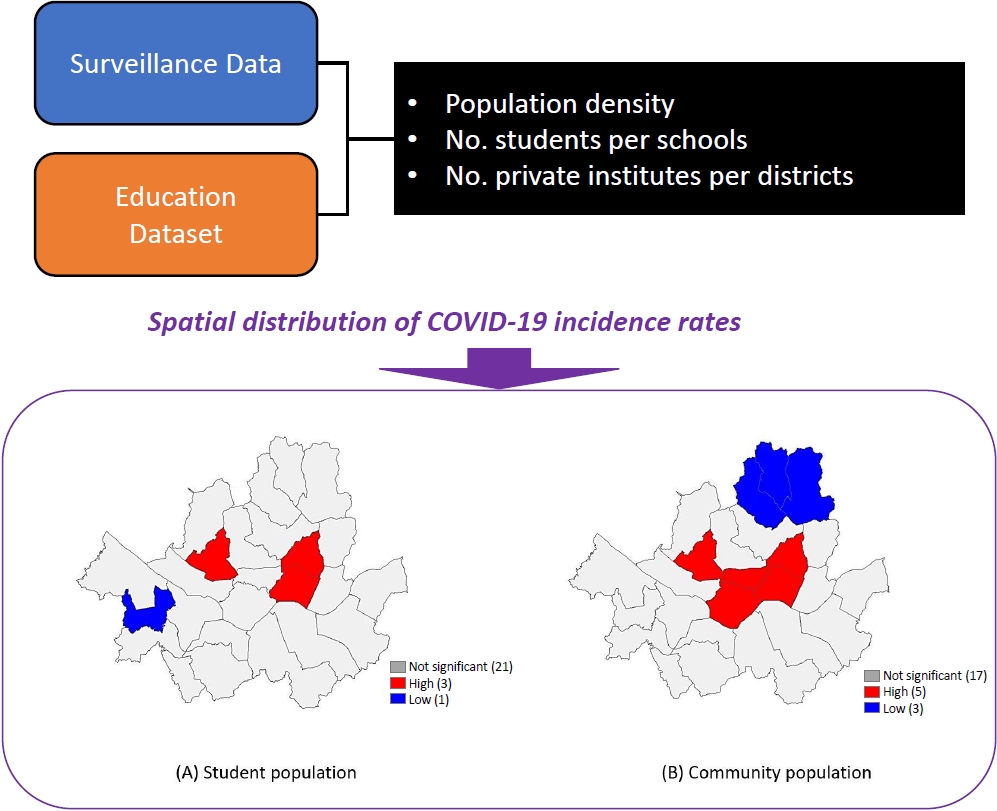
Question: What is the spatial distribution and determinants of coronavirus disease 2019 (COVID-19) infection among students in Korea?
Finding: The community population was closely associated with the risk of COVID-19, and the number of students per school class were inversely associated with COVID-19 rates in students.
Meaning: Our finding suggests that controlling the community-level burden of COVID-19 can help prevent sudden acute respiratory syndrome coronavirus 2 infection in school-aged children.
- Editorial
- Infection
- Importance of maintaining a high childhood vaccination rate and surveillance program against Japanese encephalitis in Korea (599 times)
- Su Eun Park
- Clin Exp Pediatr. 2022;65(3):127-128. Published online February 16, 2022
-
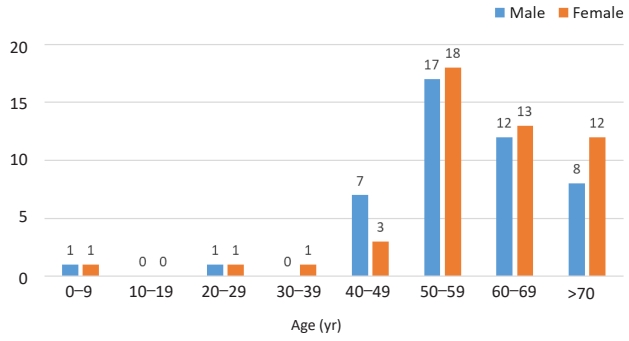
∙ Recent epidemiologic changes of Japanese encephalitis (JE) in Korea are area (rural to urban or suburban) and age shift (children to adult).
∙ Although the main factors contributing to recent epidemiologic changes of JE are not well identified, maintaining high vaccination rates of JE appear to be important in preventing of JE in all age groups.
∙ Continuous surveillance for epidemiology and seroprevalence should be carried out.
- Nephrology (Genitourinary)
- Optimal hemodialysis treatment for pediatric kidney failure patients (583 times)
- Yo Han Ahn
- Clin Exp Pediatr. 2023;66(3):125-126. Published online February 15, 2023
-
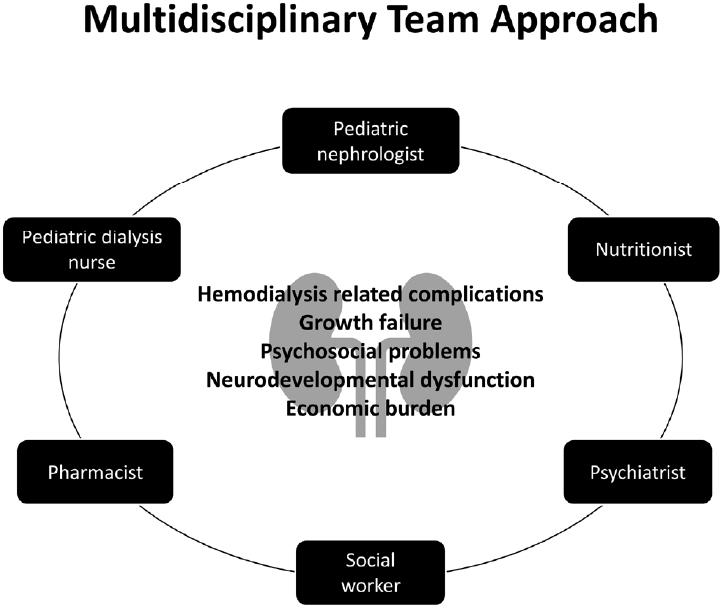
· Although the basic concept of hemodialysis (HD) is similar in adults and children, specific factors must be considered in the latter, including the small dialyzer and circuit, difficult vascular access, and frequent complications.
· HD-associated complications include catheter-related problems, hemodynamic instability, and neurodevelopmental and cognitive dysfunction.
· Pediatric HD is challenging, and steady efforts are needed to perform it safely and reduce its complications, thereby improving clinical outcomes.
- Clinical Note
- Other
- Novel PTRH2 gene variant causing IMNEPD (infantile-onset multisystem neurologic, endocrine, and pancreatic disease) in 2 Saudi siblings (578 times)
- Dalal K. Bubshait
- Clin Exp Pediatr. 2023;66(5):223-225. Published online March 23, 2023
-
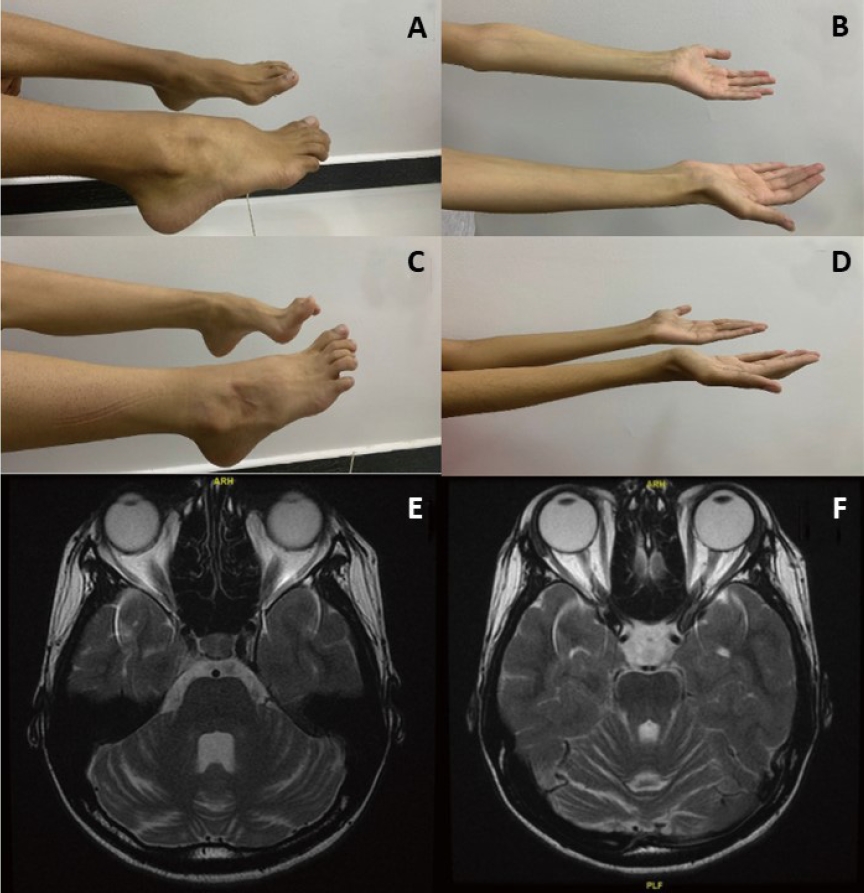
- Editorial
- Endocrinology
- Is type 1 diabetes related to coronavirus disease 2019 in children? (574 times)
- Minsun Kim
- Clin Exp Pediatr. 2022;65(5):252-253. Published online March 29, 2022
-
· Evidence shows that patients with type 1 diabetes have been severely affected by coronavirus disease 2019 (COVID-19) in various ways.
· Although there is no reliable evidence that COVID-19 worsens or induces diabetes, it can impair β-cell insulin secretion and glucose control by inducing inflammation and cytokine production.
· A study is needed of the short- and long-term relationship between diabetes and COVID-19 in the Korean pediatric population.
- Neurology
- Cerebrospinal fluid biomarkers in various pediatric neurologic diseases (570 times)
- Jeongho Lee
- Clin Exp Pediatr. 2022;65(2):81-82. Published online January 6, 2022
-

Cerebrospinal fluid (CSF) has many important biomarkers that are commonly analyzed in pediatric neurologic diseases, including central nervous system infection and inflammation. Neurologic disease in pediatrics is difficult to diagnosis, there are challenges in developing CSF profiles. Some biomarkers are expected to help differential diagnosis.
- Infection
- Effects of nonpharmaceutical interventions for coronavirus disease 2019 (568 times)
- Jae Hong Choi
- Clin Exp Pediatr. 2022;65(5):250-251. Published online March 22, 2022
-
∙ Nonpharmaceutical interventions (NPIs) have decreased the incidence of various infectious diseases, including coronavirus disease 2019 (COVID-19).
∙ During the 2-year COVID-19 pandemic, NPIs changed patients’ daily lives, and the impact on mental health was notable.
∙ The effects of NPIs were evaluated in detail, considering both infections and mental health.
- Endocrinology
- Low bone mineral density can occur in children after shortterm systemic glucocorticoid treatment (564 times)
- Moon Bae Ahn
- Clin Exp Pediatr. 2022;65(6):300-301. Published online April 27, 2022
-

Osteoporosis diagnosed in children with chronic diseases is a major endocrine complication triggered by the disease itself or its treatment. Although age upon starting osteotoxic agents and the their duration of use are vital contributors, spontaneous recovery of bone mass following treatment completion is a privilege of this specific age group. For any patients short-term glucocorticoid therapy, bone health screening is the next step.
- Letter to the Editor
- Infection
- SARS-CoV-2 fecal shedding pattern in pediatric patients with acute COVID-19 or COVID-19-associated multisystem inflammatory syndrome (558 times)
- Setareh Mamishi, Fatemeh Jalali, Sepideh Benvari, Babak Pourakbari, Mohammad Reza Abdolsalehi, Reihaneh Hosseinpour Sadeghi, Mohammad Shahbabaie, Amene Navaeian, Shima Mahmoudi
- Clin Exp Pediatr. 2023;66(8):366-368. Published online June 14, 2023
-
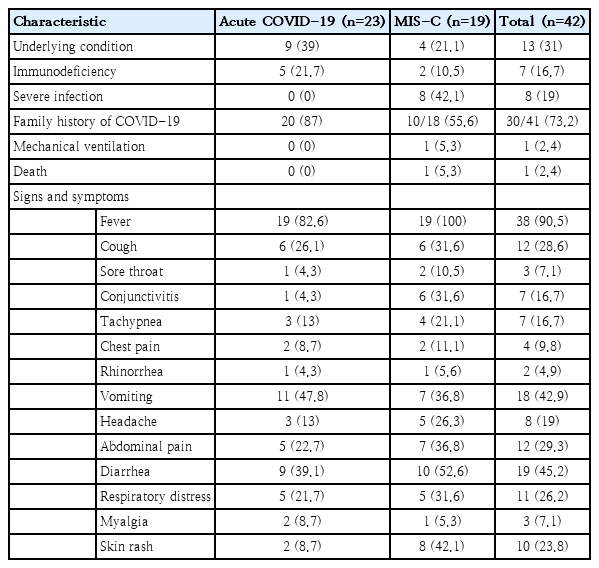
- Original Article
- Cardiology
- Early myocardial functional abnormalities in primary dyslipidemia: clinical and echocardiographic observations in young children from a highly consanguineous population (554 times)
- Nehal M. El-koofy, Aya M. Fattouh, Areef Ramadan, Mohamed A. Elmonem, Dina H. Hamed
- Clin Exp Pediatr. 2022;65(8):410-416. Published online December 8, 2021
-
In children with primary dyslipidemia, functional myocardial abnormalities can occur at young age, including diastolic functional impairment of both ventricles and narrowing of the aortic valve and the sinus of Valsalva. Echocardiographic evaluations of high-risk children may be as important as biochemical evaluations.
- Editorial
- Endocrinology
- Pediatricians must consider familial environment when diagnosing and managing childhood obesity (548 times)
- Young Suk Shim
- Clin Exp Pediatr. 2022;65(1):31-32. Published online April 19, 2021
-
•The prevalence of childhood obesity is increasing worldwide, including in the Republic of Korea, creating a major public healthissue.
•Accumulated evidence indicates a strong relationship between parentalandchildobesity.
•A family-based approach is indicated to prevent and manage childhoodandadultobesity.
- Neonatology (Perinatology)
- Ideal timing for aggressive screening to detect developmental dysplasia of the hip in term and preterm infants (547 times)
- Won-Ho Hahn
- Clin Exp Pediatr. 2022;65(7):346-347. Published online March 14, 2022
-
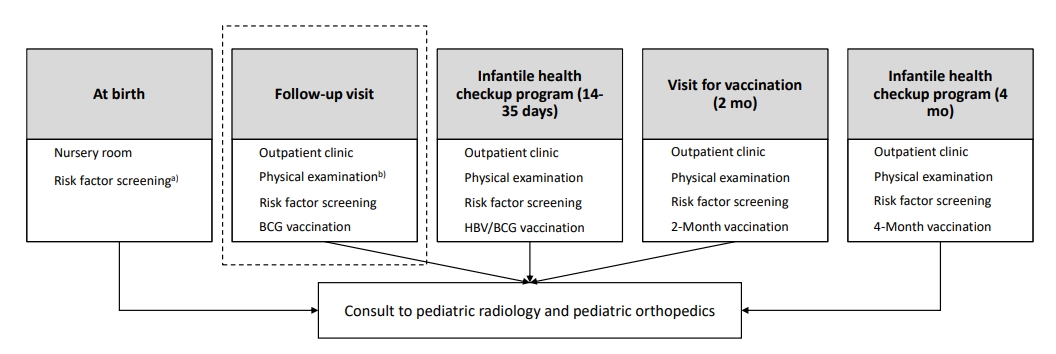
The risk factors and pathogenesis of developmental dysplasia of the hip (DDH) are unclear. Moreover, no universal screening method can entirely eliminate the risk of DDH. However, its incidence is significant and its early detection is critical for improving patient prognosis. Although the ideal evaluation time and risk factors, especially for premature infants, are unclear, the necessity for DDH screening programs for term and preterm infants is emerging.
- Does cord blood cortisol have a mediating effect on maternal prepregnancy body mass index and birth weight? (537 times)
- Gyu Hong Shim
- Clin Exp Pediatr. 2023;66(1):24-25. Published online November 30, 2022
-
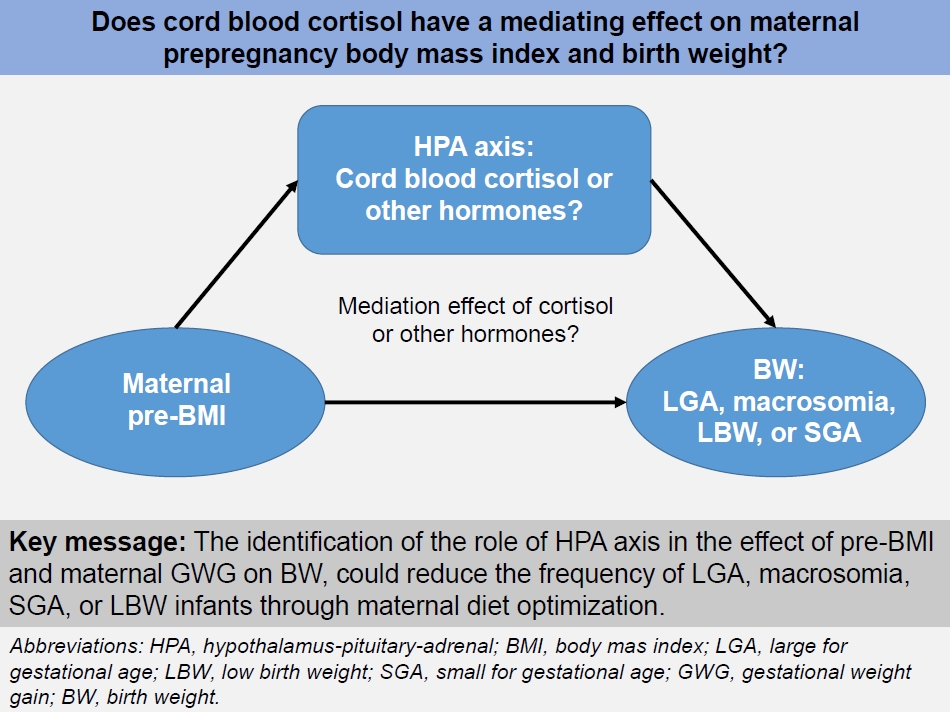
· A high prepregnancy body mass index (pre-BMI) is associated with large for gestational age (LGA) and macrosomia, whereas a low pre-BMI is associated with small for gestational age (SGA) and low birth weight (LBW).
· The identification of the role of the hypothalamus-pituitary-adrenal axis in the effect of pre-BMI and maternal gestational weight gain on birth weight could reduce the frequency of LGA, macrosomia, SGA, or LBW through maternal diet optimization.
- Correspondence
- Cardiology
- The authors reply: Age-, sex-, and height-based blood pressure reference charts, Yazd children 6–18 years, Iran (537 times)
- Seyedeh Mahdieh Namayandeh, Nastran Ahmadi, Seyed Mahmood Sadr
- Clin Exp Pediatr. 2023;66(9):414-414. Published online June 14, 2023
-
- Editorial
- Nephrology (Genitourinary)
- Hypertension in adulthood is programmed during the perinatal period (536 times)
- Min Hyun Cho
- Clin Exp Pediatr. 2022;65(10):494-495. Published online August 12, 2022
-
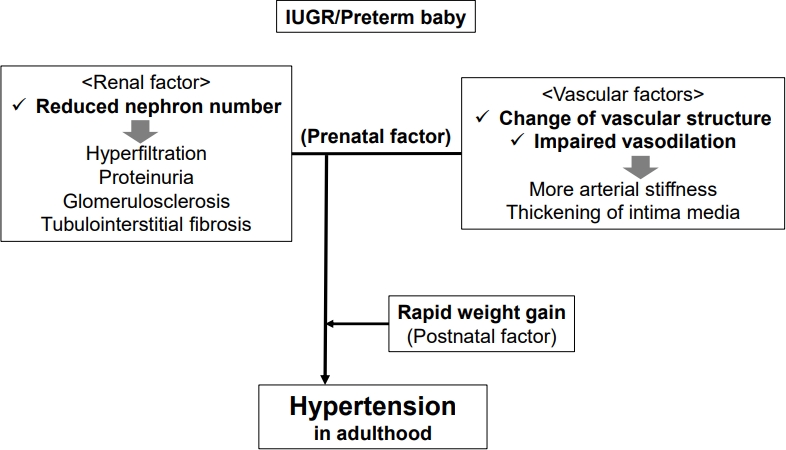
∙ Intrauterine growth restriction (IUGR) and preterm birth can be significant risk factors for the development of adult hypertension.
∙ Several perinatal factors of hypertension are related to IUGR, including renal, vascular, and rapid catch-up growth.
- Cardiology
- Arrhythmias in pediatric patients with COVID-19 (534 times)
- Ji-Eun Ban
- Clin Exp Pediatr. 2023;66(8):348-349. Published online June 14, 2023
-
· Childrens with coronavirus disease 2019 less commonly display life-threatening arrhythmias, including premature atrial or ventricular beats, or conduction disturbances such as first-degree atrioventricular blocks.
· Life-threatening arrhythmias (e.g., nonsustained or sustained ventricular tachycardia, atrial tachycardia, atrial fibrillation, complete atrioventricular block) occur in children with sudden acute respiratory syndrome coronavirus-2 infection suffering from myocarditis or multisystem inflammatory syndrome in children (MIS-C).
· Monitoring clinical status and assessing and managing arrhythmias are crucial in MIS-C.
- Correspondence and Reply
- Neurobehavior
- Association between polycystic ovary syndrome and risk of attention-deficit/hyperactivity disorder in offspring: a meta-analysis (533 times)
- Hadith Rastad, Mahnaz Seifi Alan
- Clin Exp Pediatr. 2022;65(3):152-152. Published online February 17, 2022
-
- Editorial
- Cardiology
- Recent research trends in Kawasaki disease-related infection (531 times)
- Hyang-Ok Woo
- Clin Exp Pediatr. 2022;65(11):538-539. Published online July 22, 2022
-
The incidence of Kawasaki disease has reportedly decreased since the coronavirus disease 2019 (COVID-19) quarantine. However, multisystem inflammatory syndrome in children has reportedly occurred more frequently in areas where COVID-19 was prevalent than in previous years. Research into the etiology of childhood and adolescent systemic vasculitis in infection-related immune responses during the COVID-19 pandemic has increased accordingly.
- Letter to the Editor
- Infection
- Chest x-ray findings in children with COVID-19: lesson learned from referral hospitals in Medan, North Sumatera, Indonesia (529 times)
- Andrew Limavady, Eka Airlangga, Ririe Fachrina Malisie, Ayodhia Pitaloka Pasaribu
- Clin Exp Pediatr. 2023;66(7):317-319. Published online May 16, 2023
-
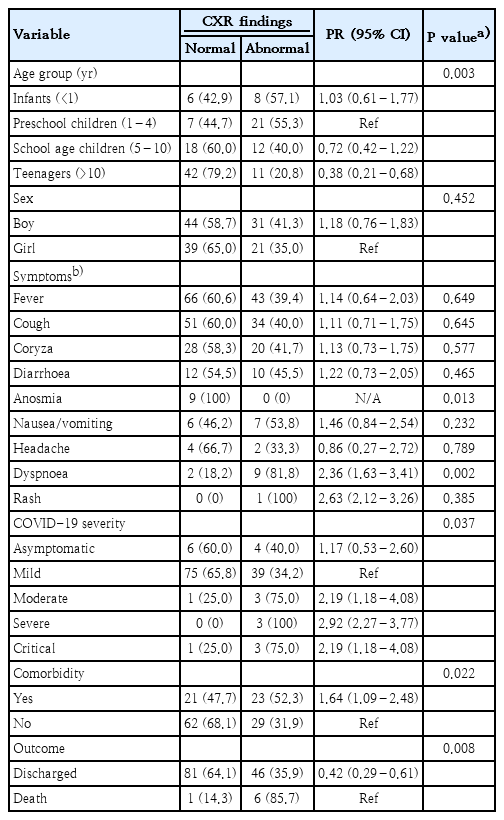
- Editorial
- Neurobehavior
- Impact of coronavirus disease 2019 on children’s health (528 times)
- Joon Won Kang
- Clin Exp Pediatr. 2022;65(10):498-499. Published online September 16, 2022
-
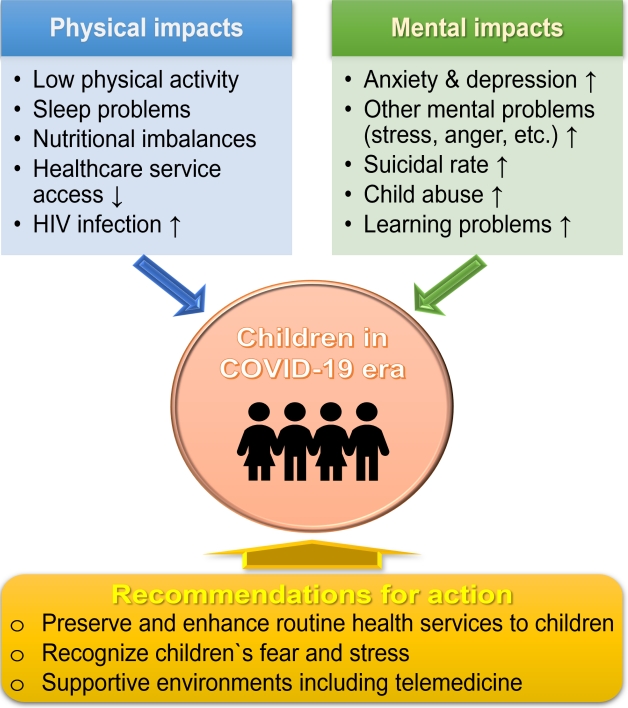
· Coronavirus disease 2019 (COVID-19) has had an enormous impact on mental health and other aspects of children’s health.
· The prevalence of anxiety, depression, and posttraumatic stress disorder in children and adolescents have increased in the COVID-19 era.
· Cooperation among parents, guardians, academic societies, and the government is needed to maintain the mental health of children and adolescents.
- Gastroenterology
- Ability of probiotics to reduce functional abdominal pain in children (527 times)
- Ji Sook Park
- Clin Exp Pediatr. 2022;65(12):585-586. Published online October 6, 2022
-
· The ability of probiotics to relieve pain caused by functional abdominal pain disorders (FAPD) in children is unclear.
· Lactobacillus reuteri may effectively reduce pain caused by childhood FAPD.
· Since the routine use of probiotics cannot be recommended due to a lack of clinical evidence, research into probiotic mixtures or symbiotics remains necessary.
- Pulmonology
- Now lung ultrasound has been established as a fundamental examination in pediatric respiratory diseases (524 times)
- Kyunghoon Kim
- Clin Exp Pediatr. 2022;65(8):401-402. Published online July 13, 2022
-
· Several studies demonstrated the usefulness of lung ultrasound in pediatric respiratory diseases including coronavirus disease 2019.
· Knowledge of lung ultrasound is increasing, and lung ultrasound has been established as a fundamental diagnostic examination for pediatric respiratory diseases.
- Neurology
- Understanding the usefulness of electroencephalography source localization (524 times)
- Bo Lyun Lee
- Clin Exp Pediatr. 2023;66(5):210-211. Published online April 18, 2023
-

· Electroencephalography (EEG) records brain activity with high temporal resolution.
· EEG source localization, combined with other functional or structural imaging methods, provides information about brain network and connectivity in clinical neuroscience.
· EEG source localization identifies brain location from electrical current sources in several neuropsychiatric diseases such as epilepsy, attention deficit/hyperactivity disorder, and anxiety disorders.
- Other
- Three-dimensional printing technolgy in orthopedic oncology (523 times)
- Yongsung Kim
- Clin Exp Pediatr. 2022;65(10):496-497. Published online May 11, 2022
-
Orthopedic oncology is one of the most active fields in applying 3-dimensional printing technology from preoperative planning to intraoperative procedures such as accurate resection of tumors and reconstruction of huge bone defects.
- Neonatology (Perinatology)
- Factors to consider before implementing telemedicine protocols to manage neonatal jaundice (522 times)
- Heui Seung Jo
- Clin Exp Pediatr. 2022;65(8):403-404. Published online April 12, 2022
-
In the rapidly changing environmental situation during the coronavirus disease 2019 outbreak, neonatal centers have developed telemedicine systems with extended coverage for neonatal monitoring and high-risk follow-up programs including neonatal hyperbilirubinemia. At this point, electronic health technology and noncontact medical system increase the effectiveness of rather than replacing the face-to-face visit and the opinions of experienced neonatologists.
- Correspondence
- General Pediatrics
- Letter to the editor: Age-, sex-, and height-based blood pressure reference charts, Yazd children 6-18 years, Iran (518 times)
- Amar Taksande
- Clin Exp Pediatr. 2023;66(9):412-413. Published online October 27, 2021
-
- Letter to the Editor
- Other
- Evaluation of simulation-based ultrasound course for pediatricians: a starting point for future training curriculum (512 times)
- Chon In Kuok, Avis Siu Ha Leung, Jonan Chun Yin Lee, Winnie Kwai Yu Chan
- Clin Exp Pediatr. 2022;65(1):53-55. Published online July 28, 2021
-

Question: Simulation-based ultrasound training is becoming more popular. Is there a role for pediatricians in such training programs?
Finding: Our program received promising feedback from its participants. Self-rated confidence in image interpretation and ultrasound-guided catheter insertion improved after the simulation. Participants reported a higher preference for performing ultrasound scans before radiologist assessment.
Meaning: Ultrasound training can be considered as part of the pediatric training curriculum in the future.
- Editorial
- Cardiology
- Early echocardiographic screening for subclinical myocardial dysfunction in children and adolescents with dyslipidemia: why and when? (506 times)
- Hyun Gyung Lee, Hwa Jin Cho
- Clin Exp Pediatr. 2022;65(8):398-400. Published online March 7, 2022
-

Dyslipidemia contributes to early atherosclerosis, premature cardiovascular disease, and subclinical ventricular dysfunction in children. This paper highlights the need for echocardiographic evaluation for impaired diastolic function of both ventricles and narrowing of the aortic valve and sinus of Valsalva. Therefore, early echocardiographic screening of children with primary hyperlipidemia should be considered.
-

-
-

-

-
Impact Factor4.2
-
6.52022CiteScore92nd percentilePowered by







